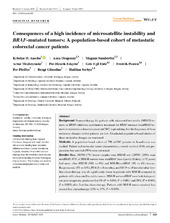| dc.contributor.author | Aasebø, Kristine | en_US |
| dc.contributor.author | Dragomir, Anca | en_US |
| dc.contributor.author | Sundström, Magnus | en_US |
| dc.contributor.author | Mezheyeuski, Artur | en_US |
| dc.contributor.author | Edqvist, Per-Henrik | en_US |
| dc.contributor.author | Eide, Geir Egil | en_US |
| dc.contributor.author | Pontén, Fredrik | en_US |
| dc.contributor.author | Pfeiffer, Per | en_US |
| dc.contributor.author | Glimelius, Bengt | en_US |
| dc.contributor.author | Sorbye, Halfdan | en_US |
| dc.date.accessioned | 2020-06-16T12:30:03Z | |
| dc.date.available | 2020-06-16T12:30:03Z | |
| dc.date.issued | 2019-05-09 | |
| dc.Published | Aasebø KØ, Dragomir A, Sundström M, Mezheyeuski A, Edqvist, Eide GE, Pontén F, Pfeiffer P, Glimelius B, Sorbye H. Consequences of a high incidence of microsatellite instability and BRAF-mutated tumors: A population-based cohort of metastatic colorectal cancer patients. Cancer Medicine. 2019;8(7):3623-3635. | eng |
| dc.identifier.issn | 2045-7634 | |
| dc.identifier.uri | https://hdl.handle.net/1956/22628 | |
| dc.description.abstract | Background: Immunotherapy for patients with microsatellite-instable (MSI-H) tumors or BRAF-inhibitors combination treatment for BRAF-mutated (mutBRAF) tumors in metastatic colorectal cancer (mCRC) is promising, but the frequency of these molecular changes in trial patients are low. Unselected population-based studies of these molecular changes are warranted.
Methods: A population-based cohort of 798 mCRC patients in Scandinavia was studied. Patient and molecular tumor characteristics, overall survival (OS) and progression-free survival (PFS) were estimated.
Results: Here, 40/583 (7%) tumor samples were MSI-H and 120/591 (20%) were mutBRAF; 87% of MSI-H tumors were mutBRAF (non-Lynch). Elderly (>75 years) had more often MSI-H (10% vs 6%) and MSI-H/mutBRAF (9% vs 4%) tumors. Response rate (5% vs 44%), PFS (4 vs 8 months), and OS (9 vs 18 months) after first-line chemotherapy was all significantly lower in patients with MSI-H compared to patients with microsatellite stable tumors. MSI-H and mutBRAF were both independent poor prognostic predictors for OS (P = 0.049, P < 0.001) and PFS (P = 0.045, P = 0.005) after first-line chemotherapy. Patients with MSI-H tumors received less second-line chemotherapy (15% vs 37%, P = 0.005).
Conclusions: In unselected mCRC patients, MSI-H and mutBRAF cases were more common than previously reported. Patients with MSI-H tumors had worse survival, less benefit from chemotherapy, and they differed considerably from recent third-line immunotherapy trial patients as they were older and most had mutBRAF tumor (non-Lynch). | |
| dc.language.iso | eng | eng |
| dc.publisher | Wiley | eng |
| dc.rights | Attribution CC BY 4.0 | eng |
| dc.rights.uri | http://creativecommons.org/licenses/by/4.0 | eng |
| dc.subject | colorectal neoplasm | eng |
| dc.subject | microsatellite instability | eng |
| dc.subject | proto‐oncogene proteins | eng |
| dc.subject | B‐raf | eng |
| dc.subject | Prognosis | eng |
| dc.subject | neoplasm metastasis | eng |
| dc.subject | KRAS protein | eng |
| dc.title | Consequences of a high incidence of microsatellite instability and BRAF-mutated tumors: A population-based cohort of metastatic colorectal cancer patients | en_US |
| dc.type | Peer reviewed | |
| dc.type | Journal article | |
| dc.date.updated | 2019-12-17T10:52:14Z | |
| dc.description.version | publishedVersion | en_US |
| dc.rights.holder | Copyright 2019 the authors | |
| dc.identifier.doi | https://doi.org/10.1002/cam4.2205 | |
| dc.identifier.cristin | 1721706 | |
| dc.source.journal | Cancer Medicine | |
| dc.identifier.citation | Cancer Medicine. 2019, 8 (7), 3623-3635. | |

